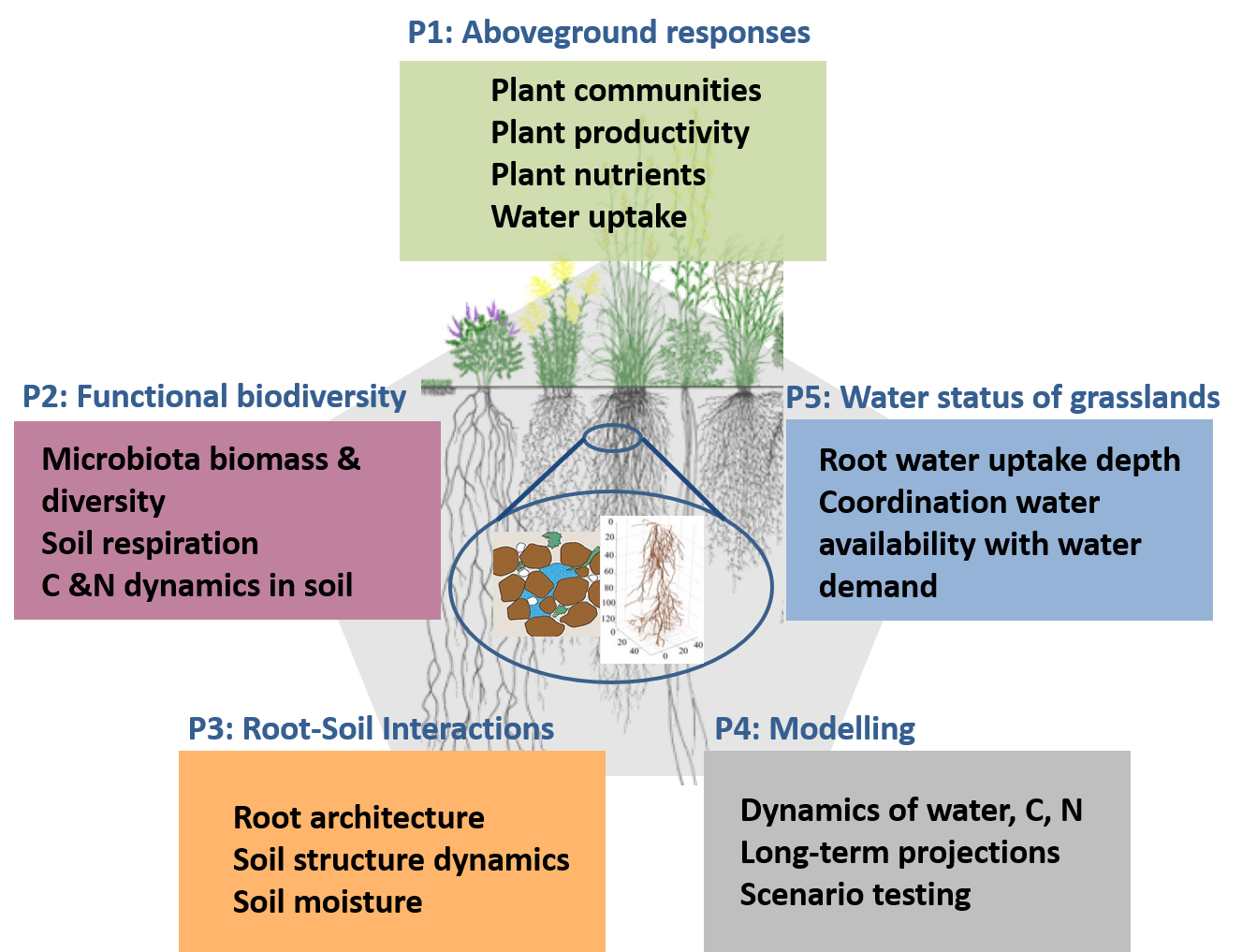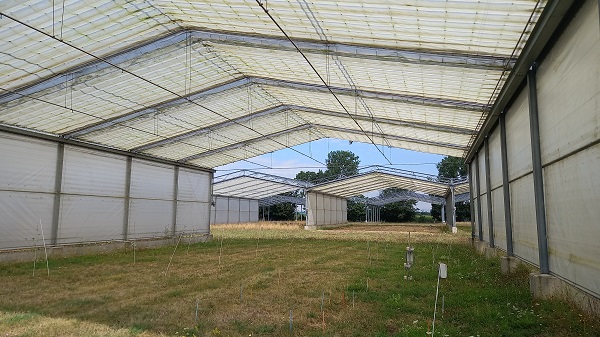
Global change impacts on microbiota-plant-soil processes relevant for water and matter cycling in agricultural ecosystems
Climate change, land use change and nitrogen deposition are among the major threats to biodiversity and associated ecosystem processes and functions, which emerge from complex interactions between organisms and their environment. Each global change driver affects the availability of and the competition for resources like water, light and nutrients differently, resulting in interacting effects on biodiversity and functional traits of above- and belowground biotic communities. However, the complex interrelation between these global change drivers on soil- and plant-related processes are poorly understood. To enable predictions on the ecosystem level, a systemic view on the interplay of above- and belowground compartments is needed. Process-based simulation models acting as a digital twin of the natural system are a promising way forward. This project team will, thus, work on several knowledge gaps at the interface between plants, soil organisms and soil structure to ultimately enable systemic modeling.
The overall hypothesis of these interlinked projects is: Climate change and increasing land-use intensity will affect water and matter cycling due to negative effects on biodiversity and soil processes mediated by soil physical properties at soil-root interface. We will use the Global Change Experimental Facility (GCEF) as a unique experimental platform for investigating climate change effects on agricultural ecosystems (croplands, grasslands) exposed to different land-use intensities. In the grasslands, we established an additional N-fertilization treatment. We study the interactive effects of climate change, land use and nitrogen addition on major biogeochemical cycles and the subsequent changes in diversity and functioning of ecosystems. The better understanding of process interactions will serve to advance the systemic soil model BODIUM (developed in the BonaRes project) and to analyze long-term effects of global change.
The PhD cohort consist of four complementary and integrated projects addressing ecosystem responses to climate and land use and the feedbacks between them (see figure below). Project P1 will investigate how global change drivers interactively affect plant diversity and plant-related ecosystem functions. Project P2 will address the interacting effects on functional traits of soil microbiota and related processes ensuring ecosystem functions and resilience. Project P3 focuses on the link between root systems and soil structure with implications for water and nutrient fluxes. Project P4 will systemically analyze the different global change effects by synthesizing the outcome of the other projects in a process-based model. An associated Project P5 investigates temporal patterns of root water uptake depths and related drought stress due to land-use intensification. The projects complement each other in multiple pairwise ways and all contribute to the overall synthesis centered on the modeling components.

Global change impacts on plant diversity and plant-related ecosystem functions
Background & Motivation:
Plants as primary producers are essential for the structure and the functioning of terrestrial ecosystems. To assess the consequences of global change for ecosystem functioning, a better understanding of how plant communities respond to global change is needed. While separate effects of climate change, land-use change and eutrophication on grassland communities and their properties have been frequently studied, their combined effects require further research.
Key research questions:
- What are the mechanisms underlying the stability of grassland productivity under climate change?
- How does nitrogen addition interact with climate change and land use in its effect on grassland plant community properties?
- How does climate change and land use interactively affect plant species-level ecophysiology?
Methods:
To answer these research questions, we use the Global Change Experimental Facility (GCEF). In the grasslands, we additionally set up a split-plot experiment to study the effects of nitrogen. Field measurements (e.g., stomatal conductance, photosynthesis) and subsequent analyses in the laboratory (e.g., specific leaf area, leaf dry matter content, nutrient analyses) are carried out on individual plant species and in addition data on grassland plant community properties (among others plant diversity and productivity) are collected.
 GCEF: Extensively used pasture under future climate treatment, May 2022
GCEF: Extensively used pasture under future climate treatment, May 2022 |
 GCEF: Extensively used meadow under future climate treatment, August 2022
GCEF: Extensively used meadow under future climate treatment, August 2022 |
_P.Beauv_336.jpg) Trisetum flavescens
Trisetum flavescens |
 Lotus corniculatus
Lotus corniculatus |
 Tragopogon orientalis
Tragopogon orientalis |
Advisors: PD Dr. Christiane Roscher, Prof. Dr. Anke Hildebrandt, Prof. Dr. Stan Harpole
Interacting effects of global change drivers on the soil fauna and microbiome
Background & Motivation:
Microorganisms have developed various strategies to cope with resource scarcity and extreme environments. They are able to metabolize a widespread range of organic compounds that are unavailable to animals or plants. Therefore - especially in soils of agricultural ecosystems with high input of organic matter - microbial life plays a crucial role in the nutrient cycling and provisioning of compounds for e.g. plant growth. Another part of the edaphon - the soil fauna – is essential for this ecosystem. Besides the role as primary decomposers, it also strongly influences soil structure and porosity through biotic activity. Ecosystem functioning is threatened by global change. However, we lack knowledge about interactive effects of different global change drivers (climate change, land use intensification and nitrogen deposition) on ecosystem functioning.
Key research questions:
How is microbial and faunal community structure affected by interacting global change drivers (climate change, land use intensification and nitrogen deposition)? Are more diverse communities more resilient and able to cope with global change effects? Is decomposition activity affected and how is it connected to changes in abiotic soil parameters?
Methods:
- annual sampling (GCEF platform) of bulk soil from 3 depths followed by lab analysis: standard analysis of abiotic soil parameters (nutrient availability, pH, moisture), soil respiration, active microbial biomass, enzymatic activity and structural composition of microbial community (amplicon sequencing)
- Annual sampling (GCEF platform) of intact soil cores for soil fauna extraction to assess diversity and density, seasonal set up of bait lamina stripes and litter bags to account for faunal decomposition activity
PhD student: Lena Philipp, lena.philipp@ufz.de
Advisors: Thomas Reitz, Evgenia Blagodatskaya, Martin Schädler, Nico Eisenhauer
Impact of land use and water regime on root-soil interactions as mediated through plant communities
Background & Motivation:
As the basic setting in which processes in soils take place, soil structure influences the root developmental program and individual root segments resulting in the plasticity of the root system during ontogeny. Inversely, root growth itself can influence soil strength and physical conditions, and this feedback process affects the accessibility of nutrients and water to plants further. The complexity of root-soil interactions and water cycles increases in systems in which not just one plant species is growing at a time (arable systems), but several species are forming a plant community (grasslands). However, the interaction of root-soil interactions and water cycling in different land use types and climate scenarios is poorly understood.
Key research questions:
Do soil structure and plant root systems develop in different directions in the different land use types, and does this driver interact with climate change? What is the time-series of soil moisture profiles in the different land use types and climate scenarios? How does root-soil interaction affect water cycles?
Methods:
- annual evaluation of classical soil physical traits and biopore-related parameters derived from X-ray computed tomography (X-ray CT) of undisturbed soil samples (porosity, pore size distribution and connectivity)
- annual determination of root length density profiles, oxidative stress enzymes and Malondialdehyde in root, tracing roots of individual species by above-ground dye application and verification with DNA based methods
- weekly monitoring of water content profiles in the field with a portable probe (TRIME Pico IPH)
PhD student: Mengqi Wu, mengqi.wu@ufz.de, 03455585215
Advisors: Dr. Steffen Schlüter, Dr. Mika Tarkka, Prof. Dr. Doris Vetterlein
Modelling the effects of global change on soil functions in different land-use types
Background & Motivation:
The effects of global change (e.g. climate change, land-use intensification) on soil-plant interactions and the related soil functions is mediated by the complex relationship of processes connecting the above- and belowground compartments. To fully understand these effects, a systemic analysis is required. Computational models are a powerful tool to simulate the dynamic interactions of different processes and compartments allowing for long-term predictions as well as scenario simulations to test the effects of various future climate projections. The main aim of this project is to develop a systemic soil model to simulate long-term effects of global change on soil functions in different land-use types.
Key research questions:
- How can computational modelling help to understand global change effects?
- How are the various soil functions (i.e. water storage, nutrient cycling, carbon storage) impacted by drought stress?
- How will the impact of global change on the different land-use types develop in the long-term?
- How is ecosystem stability and resilience in different land-use intensities affected by extreme climate events?
Methods:
The systemic soil model BODIUM, which is designed for cropping systems, will be used as a model framework. The model will be extended to be able to tackle the different research questions. Grassland will be integrated by developing an approach to describe plant communities based on different root growth characteristics with effective parameters. Further, fungal dynamics will be integrated to account for the difference between bacteria and fungi in terms of growth strategies and resistance. The model extensions will be verified with data delivered by the other projects.
Scenario simulations will be performed to test different hypotheses. For this, the different model components will be parametrized with data gained by the other projects and sensitivity analysis will be performed on these parameters.
PhD student: Lucas Kanagarajah, lucas.kanagarajah@ufz.de
Advisors: Dr. Sara König, Dr. Franziska Taubert, Prof. Dr. Hans-Jörg Vogel
Impact of climate and cultivation on the water status and the drought vulnerability of grasslands – measurement-based proof of concept and integration into hydrological modelling
Background and motivation
Vegetation is the main path for water to be transported from soil to the atmosphere. Different processes are impacting this transport such as photosynthetic activity, atmospheric water demand and available soil water. Given that the latter both are more or less constant over a longer time period depending on climate, in theory, the vegetation coordinates itself between belowground water supply and aboveground water demand in a way that its productivity is maximized for the specific location characteristics. This optimality approach of adapted vegetation was shown by different model approaches and is also used by hydrological models or for drought assessment. However, a measurement-based validation of the applicability of this theory was not given yet. Therefore, in this investigation, we are aiming for a proof of concept based on measured data for grasslands as exemplary site-adapted vegetation. Additionally, preservation and extent of grassland ecosystems are part of the mitigation strategies for climate change given by EU law. Nevertheless, how grasslands of a certain management themselves react to climate change thereby is unclear. Thus, here, we are also observing below- and aboveground reactions of differently managed grassland types to temporally changing precipitation patterns.
Key research questions
- Do adapted (extensive) grasslands coordinate their water demand with water availability
- How does grassland vegetation react on different/changing water availability in the belowground?
- How dependent is the water status of grasslands on different cultivation?
- Will there be an impact on drought resilience and resistance with climate change?
Methods
To reach the goals of this investigation, we concurrently observe belowground water availability and aboveground water demand by using proxy measures. Water availability is given by the plant available soil water storage which can be derived from the maximum depth of root water uptake and the volume of plant available soil water (soil characteristic). Root water uptake thereby is estimated from diurnal fluctuation of soil moisture during drying periods. The proxy used for aboveground water demand relies on the leaf area of the vegetation. The linkage between below- and aboveground measures is done via productivity proxies such as the ratio of transpiration to potential evapotranspiration and normalized peak biomass. Three differently managed grasslands with and without precipitation manipulation at the GCEF are used for the data acquisition. Statistical models (linear mixed effects models) are applied to look for differences in key variables between the cultivation types and the precipitation treatments.
PhD Student: Sven Westermann, sven.westermann@ufz.de
Advisory Team: Prof. Dr. Anke Hildebrandt, Dr. Stephan Thober, Dr.-Ing. Jan Bumberger
